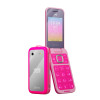Review: Pantech Breeze IV for AT&T
Menus
The Breeze IV offers two menu modes: Breeze Mode (heh heh, get it?), and Advanced Mode. Breeze Mode is for either toddlers or seniors. It boils the entire user interface down into a series of short lists. It ditches all the fun graphics and images, and is as plain and simple as it gets. The text is large, the font is blocky, and everything is easy to read and understand.
The Advanced Mode runs like a more standard feature phone operating system. That means the main menu is a grid of 12 icons that are animated and each take you to different functions. You can use the d-pad to navigate through this menu or use dialpad shortcuts. It's quite easy to figure out.
Both modes allow you to adjust the on-screen text to ginormous sizes for those with poor eyesight. Both modes allow you to program the three buttons across the top of the phone to perform a number of tasks. They can be set as calling shortcuts, but also to open the alarm clock, pill reminder, user guide, calculator, notepad, stop watch, and so on.
As far as customization is concerned, the B4 lets you pick between two color themes, set your own wallpaper, set tons of calling behaviors, switch sound profiles, and more.
Calls and Contacts
Flip phones are pretty straightforward when it comes to making calls. Dial the number and press send. Or, create a numeric shortcut on the dialpad. The B4 supports up to 99 of them. Once you actually press send and the call is connected, you can send it to the speakerphone, mute the microphone, or slow the speech down to make it easier to understand. This is a bit weird (for normal folks) and makes it sound like a slow record. For those who are hard of hearing, this could be very helpful. The phone also lets users access the browser, text messages, contact, and notepad apps when in a call.
The contact application is a pain in the arse to set up, but that's because the B4 is a feature phone and not a smartphone. The menu system controlling the address book is plain and straightforward. Actually entering in numbers and names is tedious thanks to the dialpad input. Alternately, the B4 supports AT&T's cloud-based contact service. I'd strongly advise you to backup your existing contacts with AT&T before activating the B4. That way, you can import them automatically when first setting up the phone.
Actual contact cards hold at least four numbers, plus email addresses, street addresses, birthdays, and so on.
Messaging
Messaging is constrained on the B4. Your two options are text messaging and mobile email. The text messaging app, which also supports pictures and video, is bare bones and clunky to work with. There is a lot of navigating and button pushing involved. Thank goodness messages are threaded into conversations. The email option is simple POP3 support for today's email services. There are presets for AIM, Yahoo, Gmail, and others. Email service is not provided free, however. User have to subscribe and pay an extra $5 per month to get it. The email app itself is heavy on lists and really only helpful for reading emails, rather than replying to them. Of course, you *can* reply, it's just a pain in the rear.
There are no social network apps available to the B4, though Facebook and Twitter can be reached through the browser.






















 Pantech Breeze IV Hits AT&T Stores for $40
Pantech Breeze IV Hits AT&T Stores for $40
 Qualcomm vs. Bullitt: Satellite Connectivity Comparison and Hands On
Qualcomm vs. Bullitt: Satellite Connectivity Comparison and Hands On
 HMD Launches Barbie Phone in US
HMD Launches Barbie Phone in US
 Newcomer Schok Makes Splash with Feature-Rich Phone for $169
Newcomer Schok Makes Splash with Feature-Rich Phone for $169
 Metro's Latest Entry-Level Phone is the TCL ION X
Metro's Latest Entry-Level Phone is the TCL ION X
 Pantech Breeze IV
Pantech Breeze IV



